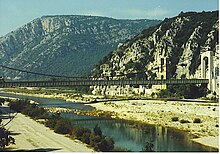Durance River
| Durance | |
|---|---|

Mirabeau Bridge over the Durance
|
|
| Country | France |
| Basin | |
| Main source |
Cottian Alps 2,300 m (7,500 ft) |
| River mouth |
Rhône 43°55′21″N 4°44′35″E / 43.92250°N 4.74306°ECoordinates: 43°55′21″N 4°44′35″E / 43.92250°N 4.74306°E |
| Progression | Rhône→ Mediterranean Sea |
| Basin size | 14,225 km2 (5,492 sq mi) |
| Physical characteristics | |
| Length | 324 km (201 mi) |
| Discharge |
|
The Durance (Durença in Occitan or Durènço in Mistralian) is a major river in south-eastern France.
Its source is in the south-western Alps, in Montgenèvre ski resort near Briançon and it flows south-west through the following departments and cities:
The Durance's main tributaries are the Bléone and Verdon. The Durance itself is a tributary of the Rhône and flows into the Rhône near Avignon. The Durance is the second longest (after the Saône) of the tributaries of the Rhône and the third largest in terms of its flow (after the Saône and Isère).
The Durance is documented in Ancient Greek as drouentios potamos and in Latin as Druentia (1st century), Durantia (854, 1271) and Durentia (1127). The traditional forms are probably derivatives of *Dūrantia, based on the Celtic "dour" (water) and suffix "ant" (stream). The Latin form drou ("hard") changed into the proto-Occitan "dur". Similar names are found in the names of many rivers in the Western Alps: Dora in Italy, Dranse in Haute-Savoie, and the Drôme in south-eastern France. All these rivers have their sources in mountains, and are fast-running.
The Durance retains its name rather than either the Clarée or Guisane, even though the latter two are longer than the Durance when they each merge. The Durance is better known than the other two rivers because the Durance valley is an old and important trade route, whereas the valleys of the Clarée and Guisane are effectively dead ends.
...
Wikipedia
